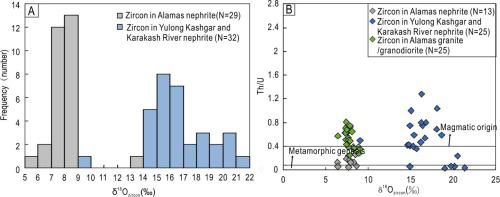Ore Geology Reviews ( IF 3.2 ) Pub Date : 2022-09-01 , DOI: 10.1016/j.oregeorev.2022.105087 Yuntao Jing , Yan Liu

|
Nephrite, an aggregate of fine-grained tremolite or actinolite, is mainly found in Mg-skarn at the contact zone between granitoids and dolomitic marble. The nephrite belt in the southern Western Kunlun Mountains in China is the largest in the world, and includes 11 major skarn deposits and >20 orebodies including the Alamas deposit. In addition, economic placer nephrite deposits occur along the Yurungkash & Karakash Rivers. The nephrite in these deposits contains numerous zircons and some grains have high δ18O values, but the genesis of these zircons is not clear. In this study, we investigated the formation mechanism of the nephrite and origin of zircons in nephrite based on the geochemical and δ18O characteristics of zircons in nephrite from the deposits at Alamas and along the Yurungkash & Karakash Rivers, as well as the C O isotopes of the dolomitic marble at Alamas. We found that zircons in nephrite often occur with tremolite and apatite and the major elements of these zircons are close to those of common magmatic zircon. Zircon grains in the Alamas nephrite are mainly subhedral, 80–130 μm long, 50–90 μm wide, and have clear oscillatory zoning. These zircons have similar REE patterns with Alamas granodiorite, including heavy REE (HREE) enrichment and large positive Ce anomalies (Ce/Ce* = 5.30–368). Such petrographic and geochemical characteristics suggest most zircons are magmatic zircons, with some experienced hydrothermal alteration. Zircon δ18O values in Alamas nephrite are 5.69 ‰–8.85 ‰ (n = 25; an exception of 13.35 ‰), close to those zircons in Alamas granodiorite (6.4 ‰–9.0 ‰) but higher than mantle magmatic zircon (5.3 ± 0.3 ‰). The δ13C (0.79 ‰–1.02 ‰) and δ18O (18.7 ‰–20.6 ‰) values of the Alamas dolomitic marble indicate formation by the partial dissolution of marine carbonate rocks. Zircons in nephrite from Yurungkash & Karakash Rivers deposits are mainly subhedral, 100–160 μm long, 80–30 μm wide, and show clear or obscure irregular zoning. They show HREE enrichment and relatively weak positive Ce anomalies (2.58–35.8), suggesting most zircons have magmatic origin, with some experienced hydrothermal alteration. Zircons from Yurungkash & Karakash Rivers have δ18O values range from 14.6 ‰ to 21.37 ‰ (n = 31; an exception of 9.03 ‰). Irregular baddeleyite grains occur in the nephrite, and fragmented or granular grains occur locally within the nephrite zircons or fissures of zircon. These baddeleyite may have formed via the following reaction between zircon and dolomite: 2Zr[SiO4] + CaMg[CO3]2 → 2ZrO2 + CaMg[SiO3]2 + 2CO2 at 660–710 ℃ and 3 kbar. In Yurungkash & Karakash Rivers nephrite deposits, considering these placer nephrite come from Mg-skarn, these high δ18O zircons probably have initially formed within endoskarn, close to the margin of the granitoid where marble with high δ18O was assimilated into the melt, and retain nice oscillatory and/or sector zoning.
O isotopes of the dolomitic marble at Alamas. We found that zircons in nephrite often occur with tremolite and apatite and the major elements of these zircons are close to those of common magmatic zircon. Zircon grains in the Alamas nephrite are mainly subhedral, 80–130 μm long, 50–90 μm wide, and have clear oscillatory zoning. These zircons have similar REE patterns with Alamas granodiorite, including heavy REE (HREE) enrichment and large positive Ce anomalies (Ce/Ce* = 5.30–368). Such petrographic and geochemical characteristics suggest most zircons are magmatic zircons, with some experienced hydrothermal alteration. Zircon δ18O values in Alamas nephrite are 5.69 ‰–8.85 ‰ (n = 25; an exception of 13.35 ‰), close to those zircons in Alamas granodiorite (6.4 ‰–9.0 ‰) but higher than mantle magmatic zircon (5.3 ± 0.3 ‰). The δ13C (0.79 ‰–1.02 ‰) and δ18O (18.7 ‰–20.6 ‰) values of the Alamas dolomitic marble indicate formation by the partial dissolution of marine carbonate rocks. Zircons in nephrite from Yurungkash & Karakash Rivers deposits are mainly subhedral, 100–160 μm long, 80–30 μm wide, and show clear or obscure irregular zoning. They show HREE enrichment and relatively weak positive Ce anomalies (2.58–35.8), suggesting most zircons have magmatic origin, with some experienced hydrothermal alteration. Zircons from Yurungkash & Karakash Rivers have δ18O values range from 14.6 ‰ to 21.37 ‰ (n = 31; an exception of 9.03 ‰). Irregular baddeleyite grains occur in the nephrite, and fragmented or granular grains occur locally within the nephrite zircons or fissures of zircon. These baddeleyite may have formed via the following reaction between zircon and dolomite: 2Zr[SiO4] + CaMg[CO3]2 → 2ZrO2 + CaMg[SiO3]2 + 2CO2 at 660–710 ℃ and 3 kbar. In Yurungkash & Karakash Rivers nephrite deposits, considering these placer nephrite come from Mg-skarn, these high δ18O zircons probably have initially formed within endoskarn, close to the margin of the granitoid where marble with high δ18O was assimilated into the melt, and retain nice oscillatory and/or sector zoning.










































 京公网安备 11010802027423号
京公网安备 11010802027423号